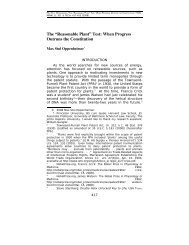An Organizational Approach to the Design of Patent Law
An Organizational Approach to the Design of Patent Law
An Organizational Approach to the Design of Patent Law
Create successful ePaper yourself
Turn your PDF publications into a flip-book with our unique Google optimized e-Paper software.
6 VERTINSKY FINAL_JAD (DO NOT DELETE) 2/27/2012 2:20 PM<br />
2012] AN ORGANIZATIONAL APPROACH 267<br />
economic conditions and <strong>the</strong>ir underlying transactional structures.<br />
238 <strong>Patent</strong> policy-makers must also be proactive in anticipating<br />
<strong>the</strong> behaviors <strong>of</strong> private ac<strong>to</strong>rs who are seeking <strong>to</strong> maximize<br />
pr<strong>of</strong>its from <strong>the</strong>ir patent rights in evolving systems <strong>of</strong><br />
technology and business.<br />
D. INTERNATIONAL PATENT LAW: NORMS & COMPLIANCE<br />
IP is essentially becoming <strong>the</strong> world’s currency <strong>of</strong> innovation.<br />
In this new environment, <strong>the</strong> global legal, economic, and<br />
innovation communities bear <strong>the</strong> challenge and responsibility <strong>of</strong><br />
creating a market-based, stable exchange rate for <strong>the</strong> currency <strong>of</strong><br />
innovation by fostering greater understanding and respect for<br />
IP. 239<br />
If intellectual property is <strong>the</strong> world’s currency <strong>of</strong> innovation,<br />
<strong>the</strong>n an understanding <strong>of</strong> how international patent law<br />
works, and how it connects with domestic patent law is critical<br />
<strong>to</strong> effective patent policy. The emergence <strong>of</strong> <strong>the</strong> international<br />
intellectual property framework complicates domestic U.S. patent<br />
policy. The two systems diverge in terms <strong>of</strong> how rules are<br />
developed, applied, and enforced; <strong>the</strong> policies and policymakers<br />
shaping U.S. patent law have his<strong>to</strong>rically been different<br />
from those driving international patent laws and patent<br />
policy. While domestic law relies on statutes and formal rules,<br />
international law relies heavily on cus<strong>to</strong>m. Yet <strong>the</strong> two systems<br />
increasingly intersect. They intersect on an administrative level<br />
through legal cases that have extra-terri<strong>to</strong>rial aspects and<br />
through concerns about compliance <strong>of</strong> domestic laws with an<br />
international framework. They intersect on a broader policy<br />
level in light <strong>of</strong> <strong>the</strong> globalization <strong>of</strong> markets and innovation<br />
processes. Traditional approaches <strong>to</strong> patent law, with <strong>the</strong>ir abstraction<br />
from <strong>the</strong> institutional environment in which rules are<br />
generated and enforced, and <strong>the</strong>ir primary focus on marketbased<br />
incentive <strong>the</strong>ories, do not readily generalize <strong>to</strong> international<br />
law settings. Nor do <strong>the</strong>y help us <strong>to</strong> explore <strong>the</strong> effects <strong>of</strong><br />
globalization on domestic patent law. As a result, domestic patent<br />
policy remains largely disconnected from international patent<br />
policy and <strong>the</strong> study <strong>of</strong> international patent law and policy<br />
238. Id. at 1586.<br />
239. David J. Kappos, Under Secretary, Speech <strong>to</strong> <strong>the</strong> National Bureau <strong>of</strong><br />
Economic Research at <strong>the</strong> National Press Club (Apr. 20, 2010) available at<br />
http://www.usp<strong>to</strong>.gov/news/speeches/2010/Remarks_Kappos_Economic_Resear<br />
ch.jsp.






